PUBLISHER: IoT Analytics GmbH | PRODUCT CODE: 1835666

PUBLISHER: IoT Analytics GmbH | PRODUCT CODE: 1835666
IoT Microcontrollers Market Report 2025-2030
A 91-page report detailing the IoT microcontrollers unit (MCU) market, including market sizing, market shares of key vendors, leading technological trends, with an overview of the broader IoT semiconductor market.
Sample preview
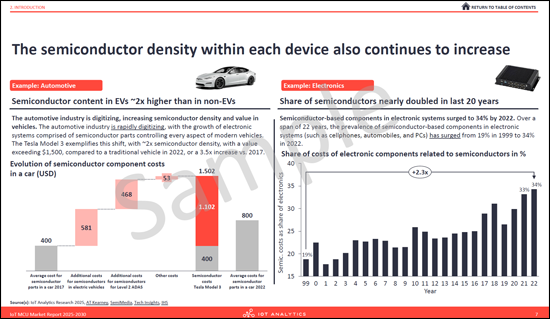
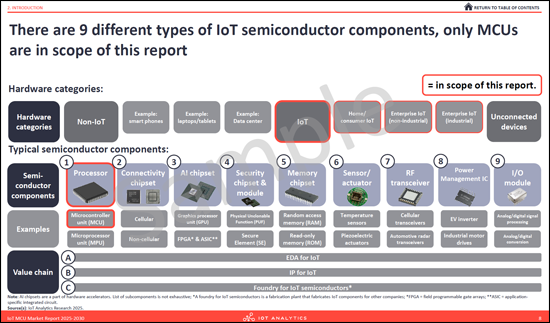
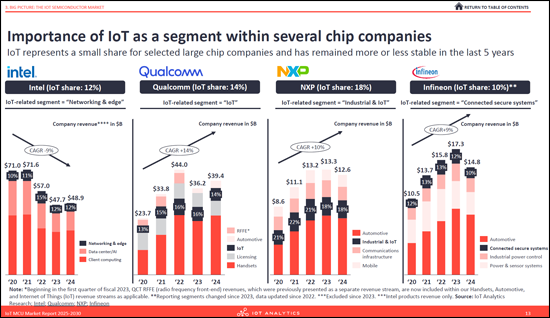
The number of connected IoT devices continues to grow, and the semiconductor density within each device is also increasing. Processors, such as microcontrollers (MCUs), are one of up to nine different types of semiconductor components typically found in an IoT device. This report provides a detailed examination of the IoT MCU market, which is a foundational category within the broader IoT semiconductor landscape.
The main purpose of this document is to help readers understand the current IoT MCU landscape by defining, sizing, and analyzing the market. It includes insights on the market size and outlook, the competitive landscape, and key technological trends and developments.
Sample preview
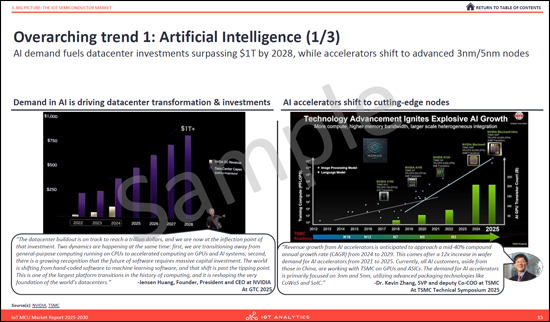
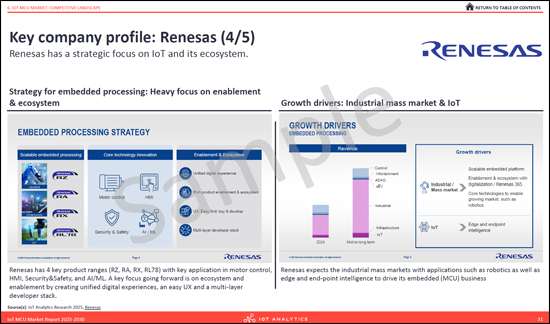
The analysis is based on in-depth primary research, including interviews with more than 20 semiconductor experts from various vendors and end-user companies conducted between November 2024 and July 2025. This is supplemented by extensive secondary research and insights gathered from leading industry trade fairs.
Sample preview
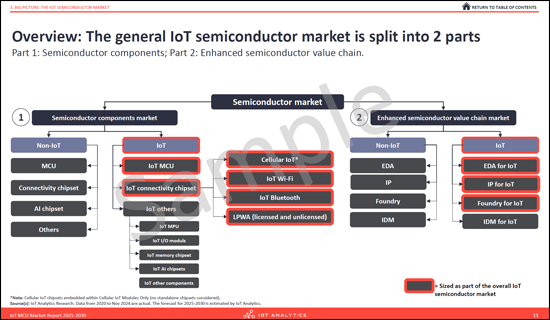
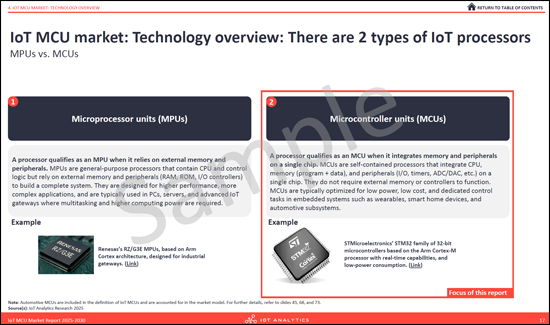
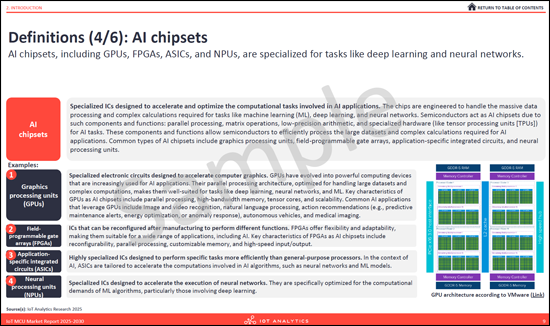
Report at a glance
- 91-page report: Detailing the IoT MCU market with a 5-year forecast from 2025 to 2030
- 4 key IoT MCU trends analyzed: A deep dive into the technological shifts shaping the market
- 5 overarching semiconductor trends: Analysis of the macro trends affecting the entire IoT semiconductor industry, including AI, security, and geopolitics
- Vendor market share analysis: A breakdown of the competitive landscape, including market shares of leading IoT MCU vendors
- Detailed market sizing and forecast: A granular look at the IoT MCU market size through 2030, with breakdowns by region
Key areas of analysis
- IoT semiconductor market overview
- Defines nine categories of IoT semiconductor components and provides a comprehensive market size analysis for both the general IoT semiconductor market and its extended value chain, including foundries, electronic design automation (EDA), and intellectual property (IP) segments. The section also highlights five overarching trends shaping the industry-AI integration, hardware security, geopolitical rivalry, strategic national investments, and supply chain diversification.
- IoT MCU technology overview
- Differentiates between microcontrollers (MCUs) and microprocessors (MPUs), outlining the defining characteristics of an "IoT MCU." This section provides an overview of MCU technology, including various bit-architecture variants and their respective suitability for IoT applications.
- IoT MCU market size and outlook
- Presents a detailed analysis of global IoT MCU market spending, including forecasts through 2030. It contextualizes IoT MCU market growth relative to non-IoT MCUs and the broader semiconductor components market. The section also includes a regional breakdown of market trends across key global markets.
- IoT MCU competitive landscape
- Analyzes the competitive landscape for IoT MCUs, featuring market share data of leading vendors by revenue. Company profiles highlight IoT strategies, product portfolios, strategic partnerships, and R&D priorities that define competitive positioning.
- Key IoT MCU trends
- Provides an in-depth examination of four major trends: the adoption of RISC-V architectures, the role of MCUs in intelligent mobility, advancements in energy efficiency, and the integration of edge AI capabilities within MCU designs
A data-driven foundation for key business functions
- Strategy and corporate development
- Leverage the five-year market forecast, regional dynamics analysis, and assessment of overarching industry trends such as geopolitical shifts and strategic national investments, to inform long-term strategic planning and corporate growth initiatives
- Product management and marketing
- Utilize insights from the analysis of four key technology trends, the competitive landscape, and detailed company profiles to shape product roadmaps, refine go-to-market strategies, and strengthen competitive positioning
- R&D and engineering leadership
- Apply findings from the technology overview and key trend analyses to guide research and development priorities, focusing on critical innovation areas such as power efficiency, hardware security, and AI integration
- Market intelligence and competitive analysis
- Use granular market share data, detailed company profiles, and evaluations of strategic industry shifts such as the transition from component-level to system-level solutions, to benchmark performance and anticipate competitive movements
Key concepts defined
Semiconductor
A material-typically silicon-that exhibits electrical conductivity between that of a conductor and an insulator, enabling it to control electrical current flow in electronic devices and components.
IoT semiconductor
Specialized semiconductor-based components that provide the core functionality and connectivity of IoT devices, including processing, communication, sensing/actuating, power management, and security. The report categorizes these components based on their intended use at the "design stage" of a product's life cycle.
Microcontroller unit (MCU)
A processor qualifies as an MCU when it integrates memory and peripherals on a single chip. MCUs are self-contained processors that integrate CPU, memory (program + data), and peripherals (I/O, timers, ADC/DAC, etc.) on a single chip. They do not require external memory or controllers to function. MCUs are typically optimized for low power, low cost, and dedicated control tasks in embedded systems such as wearables, smart home devices, and automotive subsystems.
IoT MCU
An MCU qualifies as an IoT MCU when it has integrated wireless connectivity (e.g., Wi-Fi, Bluetooth, ...). IoT MCUs are typically optimized for ultra-low power consumption and typically embed hardware-based security features; however, some may rely on software-based mechanisms to secure lightweight data processing tasks in IoT devices.
Questions answered:
- What are IoT semiconductors and IoT MCUs (i.e., definition and types of IoT semiconductors)?
- Which technologies are used for IoT semiconductors?
- How does the competitive landscape for IoT MCUs look like and what are the market shares of leading vendors?
- What is the current and forecasted market size for the IoT MCU market?
- What regional dynamics shape the IoT MCU market?
- What are the emerging trends in the IoT MCU space?
Companies mentioned:
A selection of companies mentioned in the report.
|
|
|
Table of Contents
1. Executive summary
2. Introduction
- 1. Chapter overview: Introduction
- 2. Starting point: The number of IoT connected devices continues to grow Expected to surpass 40 billion by 2030
- 3. The semiconductor density within each device also continues to increase
- 4. There are 9 different types of IoT semiconductor components, only MCUs are in scope of this report
- 5. Definitions (1/6): Semiconductors & IoT semiconductors
- 6. Definitions (2/6): Processors
- 7. Definitions (3/6): Connectivity chipsets
- 8. Definitions (4/6): AI chipsets
- 9. Definitions (5/6): Security chipsets
- 10. Definitions (6/6): Other key components
3. Big picture: The IoT semiconductor market
- 1. Chapter overview: Big picture: The IoT semiconductor market
- 2. Overview: The general IoT semiconductor market is split into 2 parts
- 3. Part 1: IoT semiconductor components Spending by type
- 4. Part 2: Enhanced IoT semiconductor value chain - Spending by value chain segment
- 5. Overall IoT semiconductor competitive landscape
- 6. Importance of IoT as a segment within several chip companies
- 7. 5 overarching trends impacting IoT semiconductors
- 8. Overarching trend 1 (3 parts)
- 9. Overarching trend 2
- 10. Overarching trend 3 (2 parts)
- 11. Overarching trend 4 (4 parts)
- 12. Overarching trend 5 (2 parts)
- 13. Recent announcements for new semiconductor plants
- 14. Methodology: Mapping IoT-related business - TSMC
4. IoT MCU market: Technology overview
- 1. Chapter overview: IoT MCU market - Technology overview
- 2. IoT MCU market: Technology overview: There are 2 types of IoT processors
- 3. IoT MCU market: Technology overview: MCUs vs IoT MCU/MPUS vs IoT MPU
- 4. IoT MCU market: Technology overview: MPU overview
- 5. IoT MCU market: Technology overview: MCU overview
5. IoT MCU market: Market size and outlook
- 1. Chapter overview: IoT MCU market-Market size and outlook
- 2. Global semiconductor component spending: MCUs vs all other components
- 3. Global MCU market spending: IoT MCUs vs non-IoT MCUs
- 4. Global IoT MCU market spending
- 5. Analyst commentary on the IoT MCU market
- 6. Global IoT MCU market spending by region
6. IoT MCU market: Competitive landscape
- 1. Chapter overview: IoT MCU-Competitive landscape
- 2. IoT MCU competitive landscape (3 parts)
- 3. Key company profile: Infineon (4 parts)
- 4. Methodology: Mapping IoT-related business - Infineon
- 5. Key company profile: Renesas (5 parts)
- 6. Methodology: Mapping IoT-related business - NXP
7. IoT MCU market: Key trends
- 1. Chapter overview: IoT MCU market - Key trends
- 2. IoT MCU trend 1
- 3. IoT MCU trend 2 (2 parts)
- 4. IoT MCU trend 3
- 5. IoT MCU trend 4 (2 parts)
8. Methodology & market definitions
- 1. Definitions
- 2. Country mappings to regions (3 parts)
- 3. Research Methodology
- 4. Methodology: How individual companies were analyzed
9. About IoT Analytics




